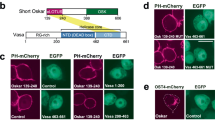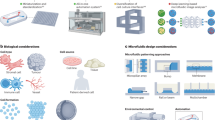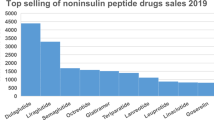Abstract
G protein–coupled receptor (GPCR) oligomers have been proposed to play critical roles in cell signaling, but confirmation of their existence in a native context remains elusive, as no direct interactions between receptors have been reported. To demonstrate their presence in native tissues, we developed a time-resolved FRET strategy that is based on receptor labeling with selective fluorescent ligands. Specific FRET signals were observed with four different receptors expressed in cell lines, consistent with their dimeric or oligomeric nature in these transfected cells. More notably, the comparison between FRET signals measured with sets of fluorescent agonists and antagonists was consistent with an asymmetric relationship of the two protomers in an activated GPCR dimer. Finally, we applied the strategy to native tissues and succeeded in demonstrating the presence of oxytocin receptor dimers and/or oligomers in mammary gland.
This is a preview of subscription content, access via your institution
Access options
Subscribe to this journal
Receive 12 print issues and online access
$259.00 per year
only $21.58 per issue
Buy this article
- Purchase on Springer Link
- Instant access to full article PDF
Prices may be subject to local taxes which are calculated during checkout





Similar content being viewed by others
References
Terrillon, S. & Bouvier, M. Roles of G-protein-coupled receptor dimerization. EMBO Rep. 5, 30–34 (2004).
Ferré, S. et al. Building a new conceptual framework for receptor heteromers. Nat. Chem. Biol. 5, 131–134 (2009).
Fotiadis, D. et al. Structure of the rhodopsin dimer: a working model for G-protein-coupled receptors. Curr. Opin. Struct. Biol. 16, 252–259 (2006).
Gomes, I. et al. A role for heterodimerization of mu and delta opiate receptors in enhancing morphine analgesia. Proc. Natl. Acad. Sci. USA 101, 5135–5139 (2004).
Wreggett, K.A. & Wells, J.W. Cooperativity manifest in the binding properties of purified cardiac muscarinic receptors. J. Biol. Chem. 270, 22488–22499 (1995).
Chidiac, P., Green, M.A., Pawagi, A.B. & Wells, J.W. Cardiac muscarinic receptors. Cooperativity as the basis for multiple states of affinity. Biochemistry 36, 7361–7379 (1997).
Urizar, E. et al. Glycoprotein hormone receptors: link between receptor homodimerization and negative cooperativity. EMBO J. 24, 1954–1964 (2005).
Waldhoer, M. et al. A heterodimer-selective agonist shows in vivo relevance of G protein–coupled receptor dimers. Proc. Natl. Acad. Sci. USA 102, 9050–9055 (2005).
Roess, D.A., Horvat, R.D., Munnelly, H. & Barisas, B.G. Luteinizing hormone receptors are self-associated in the plasma membrane. Endocrinology 141, 4518–4523 (2000).
Patel, R.C. et al. Ligand binding to somatostatin receptors induces receptor-specific oligomer formation in live cells. Proc. Natl. Acad. Sci. USA 99, 3294–3299 (2002).
Bazin, H., Trinquet, E. & Mathis, G. Time resolved amplification of cryptate emission: a versatile technology to trace biomolecular interactions. J. Biotechnol. 82, 233–250 (2002).
Terrillon, S. et al. Oxytocin and vasopressin V1a and V2 receptors form constitutive homo- and heterodimers during biosynthesis. Mol. Endocrinol. 17, 677–691 (2003).
Devost, D. & Zingg, H.H. Identification of dimeric and oligomeric complexes of the human oxytocin receptor by co-immunoprecipitation and bioluminescence resonance energy transfer. J. Mol. Endocrinol. 31, 461–471 (2003).
Cottet, M. et al. Past, present and future of vasopressin and oxytocin receptor oligomers, prototypical GPCR models to study dimerization processes. Curr. Opin. Pharmacol. 1, 59–66 (2009).
Armstrong, D. & Strange, P.G. Dopamine D2 receptor dimer formation: evidence from ligand binding. J. Biol. Chem. 276, 22621–22629 (2001).
Guo, W. et al. Dopamine D2 receptors form higher-order oligomers at physiological expression levels. EMBO J. 27, 2293–2304 (2008).
Javitch, J.A. The ants go marching two by two: oligomeric structure of G-protein-coupled receptors. Mol. Pharmacol. 66, 1077–1082 (2004).
Vivo, M., Lin, H. & Strange, P.G. Investigation of cooperativity in the binding of ligands to the D(2) dopamine receptor. Mol. Pharmacol. 69, 226–235 (2006).
Albizu, L. et al. Probing the existence of G protein–coupled receptor dimers by positive and negative ligand-dependent cooperative binding. Mol. Pharmacol. 70, 1783–1791 (2006).
Albizu, L. et al. Towards efficient drug screening by homogeneous assays based on the development of new fluorescent vasopressin and oxytocin receptor ligands. J. Med. Chem. 50, 4976–4985 (2007).
Durroux, T. et al. Fluorescent pseudo-peptide linear vasopressin antagonists: design, synthesis, and applications. J. Med. Chem. 42, 1312–1319 (1999).
Mathis, G. Probing molecular interactions with homogeneous techniques based on rare earth cryptates and fluorescence energy transfer. Clin. Chem. 41, 1391–1397 (1995).
Selvin, P.R. & Hearst, J.E. Luminescence energy transfer using a terbium chelate: improvements on fluorescence energy transfer. Proc. Natl. Acad. Sci. USA 91, 10024–10028 (1994).
Mouillac, B., Manning, M. & Durroux, T. Fluorescent agonists and antagonists for vasopressin/oxytocin G protein–coupled receptors: usefulness in ligand screening assays and receptor studies. Mini Rev. Med. Chem. 8, 996–1005 (2008).
Chini, B. et al. Two aromatic residues regulate the response of the human oxytocin receptor to the partial agonist arginine vasopressin. FEBS Lett. 397, 201–206 (1996).
Serradeil-Le Gal, C. et al. Binding properties of a selective tritiated vasopressin V2 receptor antagonist, [H]-SR 121463. Kidney Int. 58, 1613–1622 (2000).
Maurel, D. et al. Cell-surface protein-protein interaction analysis with time-resolved FRET and snap-tag technologies: application to GPCR oligomerization. Nat. Methods 5, 561–567 (2008).
Christopoulos, A. & Kenakin, T. G protein–coupled receptor allosterism and complexing. Pharmacol. Rev. 54, 323–374 (2002).
Durroux, T. Principles: a model for the allosteric interactions between ligand binding sites within a dimeric GPCR. Trends Pharmacol. Sci. 26, 376–384 (2005).
Christopoulos, A., Lanzafame, A., Ziegler, A. & Mitchelson, F. Kinetic studies of co-operativity at atrial muscarinic M2 receptors with an “infinite dilution” procedure. Biochem. Pharmacol. 53, 795–800 (1997).
Breton, C. et al. Direct identification of human oxytocin receptor-binding domains using a photoactivatable cyclic peptide antagonist: comparison with the human V1a vasopressin receptor. J. Biol. Chem. 276, 26931–26941 (2001).
Cotte, N. et al. Identification of residues responsible for the selective binding of peptide antagonists and agonists in the V2 vasopressin receptor. J. Biol. Chem. 273, 29462–29468 (1998).
Mouillac, B. et al. Mapping peptide antagonist binding sites of the human V1a and V2 vasopressin receptors. Adv. Exp. Med. Biol. 449, 359–361 (1998).
Phalipou, S. et al. Mapping peptide-binding domains of the human V1a vasopressin receptor with a photoactivatable linear peptide antagonist. J. Biol. Chem. 272, 26536–26544 (1997).
Terrillon, S. et al. Synthesis and characterization of fluorescent antagonists and agonists for human oxytocin and vasopressin V(1)(a) receptors. J. Med. Chem. 45, 2579–2588 (2002).
Han, Y., Moreira, I.S., Urizar, E., Weinstein, H. & Javitch, J.A. Allosteric communication between protomers of dopamine class A GPCR dimers modulates activation. Nat. Chem. Biol. 5, 688–695 (2009).
Barki-Harrington, L., Luttrell, L.M. & Rockman, H.A. Dual inhibition of beta-adrenergic and angiotensin II receptors by a single antagonist: a functional role for receptor-receptor interaction in vivo. Circulation 108, 1611–1618 (2003).
Damian, M., Martin, A., Mesnier, D., Pin, J.P. & Baneres, J.L. Asymmetric conformational changes in a GPCR dimer controlled by G-proteins. EMBO J. 25, 5693–5702 (2006).
Guo, W., Shi, L. & Javitch, J.A. The fourth transmembrane segment forms the interface of the dopamine D2 receptor homodimer. J. Biol. Chem. 278, 4385–4388 (2003).
Vilardaga, J.P. et al. Conformational cross-talk between alpha2A-adrenergic and mu-opioid receptors controls cell signaling. Nat. Chem. Biol. 4, 126–131 (2008).
Springael, J.Y. et al. Allosteric modulation of binding properties between units of chemokine receptor homo- and hetero-oligomers. Mol. Pharmacol. 69, 1652–1661 (2006).
Goudet, C. et al. Asymmetric functioning of dimeric metabotropic glutamate receptors disclosed by positive allosteric modulators. J. Biol. Chem. 280, 24380–24385 (2005).
Hlavackova, V. et al. Evidence for a single heptahelical domain being turned on upon activation of a dimeric GPCR. EMBO J. 24, 499–509 (2005).
Springael, J.Y., Urizar, E. & Parmentier, M. Dimerization of chemokine receptors and its functional consequences. Cytokine Growth Factor Rev. 16, 611–623 (2005).
Ciruela, F. et al. Metabotropic glutamate 1alpha and adenosine A1 receptors assemble into functionally interacting complexes. J. Biol. Chem. 276, 18345–18351 (2001).
Sohy, D. et al. Hetero-oligomerization of CCR2, CCR5, and CXCR4 and the protean effects of “selective” antagonists. J. Biol. Chem. 284, 31270–31279 (2009).
Daniels, D.J. et al. Opioid-induced tolerance and dependence in mice is modulated by the distance between pharmacophores in a bivalent ligand series. Proc. Natl. Acad. Sci. USA 102, 19208–19213 (2005).
Hague, C., Uberti, M.A., Chen, Z., Hall, R.A. & Minneman, K.P. Cell surface expression of alpha1D-adrenergic receptors is controlled by heterodimerization with alpha1B-adrenergic receptors. J. Biol. Chem. 279, 15541–15549 (2004).
Chabre, M., Deterre, P. & Antonny, B. The apparent cooperativity of some GPCRs does not necessarily imply dimerization. Trends Pharmacol. Sci. 30, 182–187 (2009).
Rives, M.L. et al. Crosstalk between GABA(B) and mGlu1a receptors reveals new insight into GPCR signal integration. EMBO J. 28, 2195–2208 (2009).
Acknowledgements
Thanks are due to S. Granier, P. Rondard and L. Prezeau for their critical reading of the manuscript. This work was supported by research grants from the Centre National de la Recherche Scientifique, Institut National de la Santé et de la Recherche Médicale, Actions Concertées Incitatives “Molécules Cibles et Thérapeutiques” (no. 240 and 355), ANR-06-BLAN-0087-03 and ANR-09-BLAN-0272) and the US National Institutes of Health (grants GM025280, DA022413, MH54137). This work was also made possible by the Plateforme de Pharmacologie-Criblage of Montpellier and the Region Languedoc-Roussillon. NAPS and PPHT amines were synthesized by the National Institute of Mental Health Chemical Synthesis and Drug Supply Program and provided by A.N. and J.J.
Author information
Authors and Affiliations
Contributions
L.A. and T.D. originated the project. L.A., M.C. and T.D. executed most of the experiments and wrote the manuscript; S.S. and M.M. performed the peptide agonist synthesis; R.S. synthesized the antagonist peptide; I.B. performed experiments with SNAP-tag receptors; M.-L.R., M.K., A.N. and J.J. contributed to the development of the fluorescent dopamine receptor ligands and assay system; T.R. characterized the dopamine ligands; H.B., E.B. and L.L. labeled the ligands with fluorophores; C.B. performed saturation experiments with [125I]OTA; E.T., B.M. and J.-P.P. supported the project and participated in the writing of the manuscript.
Corresponding authors
Ethics declarations
Competing interests
T.R., H.B., E.B., L.L.and E.T. are employees of Cisbio, which develops HTRF compatible fluorescent ligands and products combining its HTRF technology with Covalys SNAP-tag protein labeling system, and therefore may gain financially through publication of this paper. Part of the work of CNRS UMR 5203 has been financially supported by Cisbio and by an unrestricted grant from Senomyx.
Supplementary information
Supplementary Text and Figures
Supplementary Tables 1–3, Supplementary Figures 1–3 and Supplementary Methods (PDF 2170 kb)
Rights and permissions
About this article
Cite this article
Albizu, L., Cottet, M., Kralikova, M. et al. Time-resolved FRET between GPCR ligands reveals oligomers in native tissues. Nat Chem Biol 6, 587–594 (2010). https://doi.org/10.1038/nchembio.396
Received:
Accepted:
Published:
Issue Date:
DOI: https://doi.org/10.1038/nchembio.396
This article is cited by
-
Are there sex differences in oxytocin and vasopressin V1a receptors ligand binding affinities?
Pharmacological Reports (2024)
-
Biased signaling due to oligomerization of the G protein-coupled platelet-activating factor receptor
Nature Communications (2022)
-
Nanobody-based sensors reveal a high proportion of mGlu heterodimers in the brain
Nature Chemical Biology (2022)
-
Fluorescent ligands for dopamine D2/D3 receptors
Scientific Reports (2020)
-
Quantification of HER1, HER2 and HER3 by time-resolved Förster resonance energy transfer in FFPE triple-negative breast cancer samples
British Journal of Cancer (2020)



